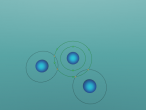DiHydrogen Monoxide Molecule
Science Assignment
Molecule Construction Blog
Construction of H2O Molecule (dihydrogen monoxide) Using Vrmath2 software
Water Is essential to all life. It is a polar inorganic compound, tasteless and odourless when room temperature and nearly colourless with a hint of blue in its liquid and solid forms but clear when it is a vapour. The water molecule is composed of two Hydrogen atoms bound to an oxygen atom at angle of approximately 105% from each-other. On the 19th of July I replicated the atomic structure of the Water Molecule using the VR2math software. The result was a computer simulated, planetary modal of H2O.
Dihydrogen monoxide is composed of both hydrogen and oxygen atoms. The two hydrogen atoms bind to an oxygen atom to creat water. The atom (hydrogen) is electrically neutral, weighs 1.008amu, and contains one single positively charged proton and one single negatively charged electron by which Coulomb force binds the two with the neutron. Oxygen is a far larger element, with 6 protons and electrons and weighing 15.999amu. Oxygen, however is still electronically neutral before bonding.
Water molecules have the chemical formula H20. This means they contain two Hydrogen atoms and one Oxygen atom. Both the Oxygen atom and the two Hydrogen atoms are bound by a covalent bond. A chemical bond that involves the sharing of electron pairs between atoms which create a stable balance of attractive and repulsive forces between atoms. In this circumstance the two Hydrogens are forced into a 104.45 degree angle due to the forces of the lone pair electrons in the oxygen atom.
Water has many characteristics, including being dipolular, or having two opposite charges. Water is given its dipolular qualities due to the nature of the bonding between its two Hydrogen and singular oxygen atoms. When the two hydrogen atoms bond to the oxygen they lose their electrons in the covalent bond creating a positive charge on the side in which the atoms are positioned due to there lack of negative electrons. However, the bonding leaves the oxygen atom with lone pairs of electrons, creating a negative charge due to the excess electrons. Water also has the highest specific heat capacity of all liquids, the highest surface tension other than Mercury and the greatest thermal conductivity other than Mercury.
This blog only gives very shallow information on the complexity of the water, it's molecular structure, characteristics and related atoms and therefore I have attached several links which give greater detail on the topic.
For more general knowledge on the water molecule;
http://witcombe.sbc.edu/water/chemistrystructure.html
For more general knowledge on the characteristics of water;
http://www.bpc.edu/mathscience/chemistry/unique_propeties_of_water.html
For more knowledge of H2O's molecular structure;
http://www1.lsbu.ac.uk/water/water_molecule.html
For general knowledge on various atoms;
Vrmath2 is a comprehensive programming software, however there are curtain difficulties I encountered while using it. To effectively place the objects with the correct 3D positioning, awareness of the turtle/place indicators position, rotation and tilt is absolutely necessary. Without this, the correct placing of objects is neigh on impossible. Apart from this the next issue encounter is the scaling of the objects, especially in regard to circles and spheres (the scaling refers to diameter in the sheer and radius in the circle). As well as these two essential techniques having to be perfected, if you want to enhance the object/model created the use of transforming and setparenting is essential and can prove difficult at times. Other than these three main difficulties the Vrmath2 software was surprisingly versatile and easy to operate, with options to enhances objects through different colours and transparencies as well as the ability repeat previous programming rather than having the necessity to retune an already consistent and persistent program step.























